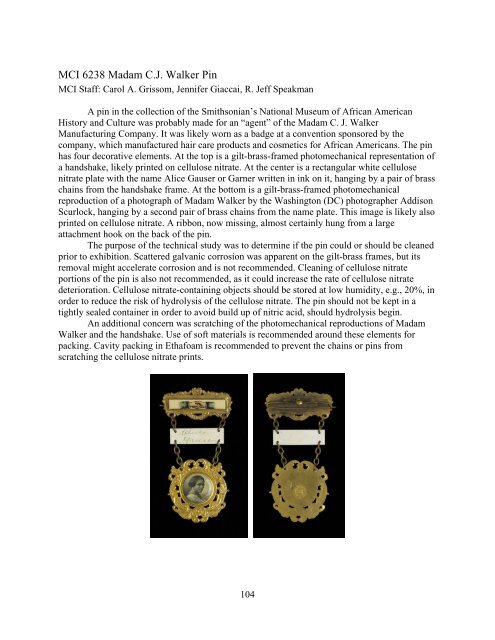MCI Project Summaries 2008 - Smithsonian Institution
MCI Project Summaries 2008 - Smithsonian Institution
MCI Project Summaries 2008 - Smithsonian Institution
You also want an ePaper? Increase the reach of your titles
YUMPU automatically turns print PDFs into web optimized ePapers that Google loves.
<strong>MCI</strong> 6238 Madam C.J. Walker Pin<br />
<strong>MCI</strong> Staff: Carol A. Grissom, Jennifer Giaccai, R. Jeff Speakman<br />
A pin in the collection of the <strong>Smithsonian</strong>’s National Museum of African American<br />
History and Culture was probably made for an “agent” of the Madam C. J. Walker<br />
Manufacturing Company. It was likely worn as a badge at a convention sponsored by the<br />
company, which manufactured hair care products and cosmetics for African Americans. The pin<br />
has four decorative elements. At the top is a gilt-brass-framed photomechanical representation of<br />
a handshake, likely printed on cellulose nitrate. At the center is a rectangular white cellulose<br />
nitrate plate with the name Alice Gauser or Garner written in ink on it, hanging by a pair of brass<br />
chains from the handshake frame. At the bottom is a gilt-brass-framed photomechanical<br />
reproduction of a photograph of Madam Walker by the Washington (DC) photographer Addison<br />
Scurlock, hanging by a second pair of brass chains from the name plate. This image is likely also<br />
printed on cellulose nitrate. A ribbon, now missing, almost certainly hung from a large<br />
attachment hook on the back of the pin.<br />
The purpose of the technical study was to determine if the pin could or should be cleaned<br />
prior to exhibition. Scattered galvanic corrosion was apparent on the gilt-brass frames, but its<br />
removal might accelerate corrosion and is not recommended. Cleaning of cellulose nitrate<br />
portions of the pin is also not recommended, as it could increase the rate of cellulose nitrate<br />
deterioration. Cellulose nitrate-containing objects should be stored at low humidity, e.g., 20%, in<br />
order to reduce the risk of hydrolysis of the cellulose nitrate. The pin should not be kept in a<br />
tightly sealed container in order to avoid build up of nitric acid, should hydrolysis begin.<br />
An additional concern was scratching of the photomechanical reproductions of Madam<br />
Walker and the handshake. Use of soft materials is recommended around these elements for<br />
packing. Cavity packing in Ethafoam is recommended to prevent the chains or pins from<br />
scratching the cellulose nitrate prints.<br />
104

















